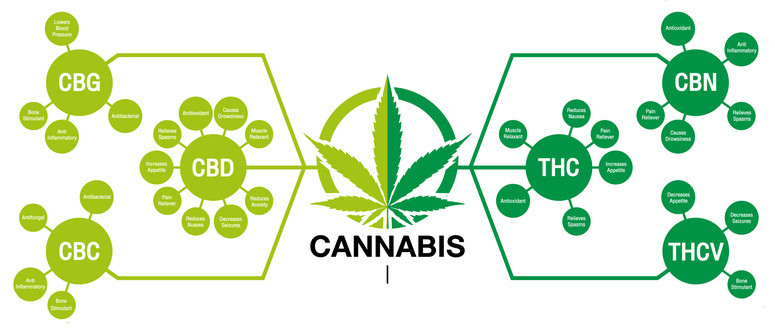How are cannabinoids made?

Ever wonder how each cannabinoid is made in cannabis? We take a look at some of the basics and explain exactly what happens to produce each major cannabinoid.
Contents:
Individual cannabinoids exert many compelling actions in the human body, but how are they created in the first place? We know that most cannabinoids are found in the cannabis plant, but which chemical reactions give rise to the different cannabinoids we know today? Exposure to different enzymes, heat, and oxygen all play a role. Let’s dive into the world of cannabinoid biosynthesis.
WHEN WERE CANNABINOIDS DISCOVERED?
The long path to understanding cannabinoids has taken place mainly over the last century. Initial research began in the 1930s, but was then disrupted during WWII. As a result, cannabinoid research only really began in earnest in the 1950s.
For the next 30 years, scientists thought cannabinoids produced their effects via nonspecific interactions with cell membranes. Intriguingly, it was eventually discovered that there are, in fact, specific receptors within the human body that interface with cannabinoids.
Currently, there are two major cannabinoid receptors identified in the human body—CB1 and CB2. However, there is growing scientific consensus that other molecular targets could be effectively influenced by cannabinoids, such as serotonin receptors.
HOW ARE CANNABINOIDS SYNTHESISED?
Cannabinoids are chemical compounds that are created over time. This includes the period of time that the plant grows, and the periods following harvest and exposure to elements like light or heat. To better visualise this process, it helps to think of cannabinoid biosynthesis like a family tree, with each branch rendering different but related outcomes.
Cannabinoid biosynthesis largely takes place in the trichomes: small glandular outgrowths that appear on cannabis buds and leaves. During the late flowering stage, these trichomes appear as a sea of resin that contains cannabinoids, terpenes, flavonoids, and other crucial chemical components.
• Production of CBGA and CBGVA
Cannabinoid production begins when fatty acids are converted to either hexanoyl-CoA or n-butyl-CoA through the polyketide pathway.
Olivetolic acid, added to hexanoyl-CoA, begins the next process of conversion, namely to “mother cannabinoid” CBGA. Divarinoic acid turns n-butyl-CoA into CBGVA. From here, the process is controlled by biosynthesis, decarboxylation, and degradation.
BIOSYNTHESIS
CBGA and CBGVA are then converted into different cannabinoids via three different synthase enzymes:
• THCA synthase turns CBGA into THCA and CBGVA into THCVA
• CBDA synthase turns CBGA into CBDA and CBGVA into CBDVA
• CBCA synthase turns CBGA into CBCA and CBGVA into CBCVA
• No synthase: CBGA that does not go through an enzymatic conversion process can still be chemically converted into CBG via harvesting, drying, and heating
DECARBOXYLATION
The chemical transformation process of cannabis does not end here. Exposure to oxygen and heat further change the chemical compounds in cannabis—this is known as decarboxylation. Decarboxylation removes a carboxyl group from cannabinoid acids like THCA and CBDA, converting them into the active cannabinoids THC and CBD. As you might imagine, this is a crucial process, as it is these activated cannabinoids that are most sought-after by consumers and scientists alike.
Decarboxylation happens naturally over time when cannabinoids are exposed to oxygen, but it happens immediately when cannabinoids are heated to a certain degree.
• THCA becomes THC
• CBDA becomes CBD
• CBCA becomes CBC
• Unconverted CBGA and CBGVA become CBG
DEGRADATION
Even after decarboxylation, there are further chemical changes that occur when cannabinoids are exposed to light, oxygen, heat, and other environmental factors.
For instance, after THCA has been decarboxylated into THC, the compound will slowly turn into CBN as it is exposed to light and heat. CBN is thought to be mildly psychoactive but non-intoxicating, unlike THC. This is the reason cannabis has a finite window of effectiveness.
This degradation process also explains why it is important to store harvested cannabis in sealed containers, and in a dark place.
• THCA and THCVA, without any heat added, become CBNA and CBVA
• THC and THCV become CBN, CBV, or delta-8-THC
• CBC and CBCV become CBL and CBLV
• CBCA becomes CBLA
• Both CBNA and delta-8-THC also convert to CBN
• Aged CBLA becomes CBL
HOW MANY CANNABINOIDS ARE THERE?
Beyond the six main cannabinoids that have been widely studied, there are literally more than a hundred that have not been.
As reform continues to spread into more countries, it is clear that cannabis research will also increase, hopefully revealing the biosynthetic pathways and effects of other cannabinoids. Even from what we know now, it is clear that cannabinoids undergo chemical reactions during cannabis plant growth, harvesting, drying, curing, and heating to form the range of cannabinoids in existence.
.jpg)


.jpg)
